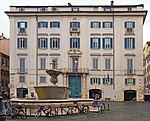Oratory of Saint Philip Neri

The Congregation of the Oratory of Saint Philip Neri is a pontifical society of apostolic life of Catholic priests and lay-brothers who live together in a community bound together by no formal vows but only with the bond of charity. They are commonly referred to as Oratorians (also Oratorian Fathers). This "Congregation of the Oratory" should not be confused with the French Oratory, a distinct congregation, the Society of the Oratory of Jesus (Société de l'Oratoire de Jésus), founded by Pierre de Bérulle in 1611 in Paris. Founded in Rome in 1575 by St. Philip Neri, today it has spread around the world, with over 70 Oratories and some 500 priests. The post-nominal initials commonly used to identify members of the society are "C.O." (Congregatio Oratorii). The abbreviation "Cong. Orat." is also used. Unlike a religious institute (the members of which take vows and are answerable to a central authority) or a monastery (the monks of which are likewise bound by vows in a community that may itself be autonomous and answerable directly to the Pope), the Oratorians are made up of members who commit themselves to membership in a particular, independent, self-governing local community (an Oratory, usually named for the place in which it is located: e.g., Birmingham Oratory, Oxford Oratory, Brooklyn Oratory) without actually taking vows, an unusual and innovative arrangement created by St. Philip. Normally an oratory must have a minimum of four members, two being ordained, in order to be founded. If a group of men seeks to establish an oratory, they may apply to do so, going through the proper diocesan channels; during the process of formation a member (or members) of a well-established oratory resides in the community to facilitate every aspect of the proposed foundation.
Excerpt from the Wikipedia article Oratory of Saint Philip Neri (License: CC BY-SA 3.0, Authors, Images).Oratory of Saint Philip Neri
Via di Parione, Rome Municipio Roma I
Geographical coordinates (GPS) Address Website Nearby Places Show on map
Geographical coordinates (GPS)
| Latitude | Longitude |
|---|---|
| N 41.898611111111 ° | E 12.470833333333 ° |
Address
Antica Bottega Artigiana Giuliani
Via di Parione 10
00186 Rome, Municipio Roma I
Lazio, Italy
Open on Google Maps









